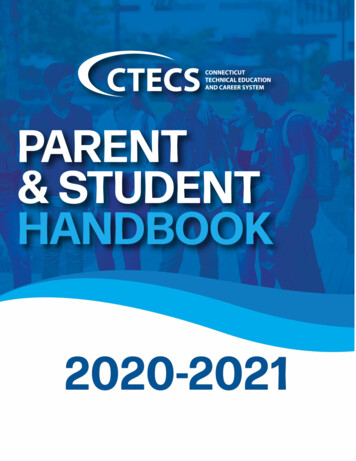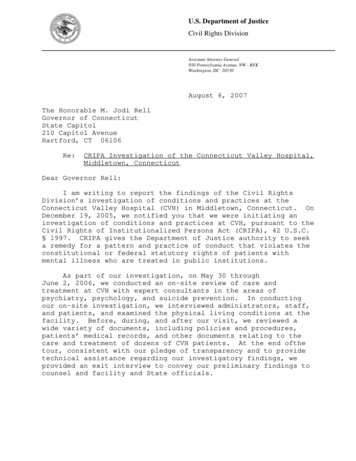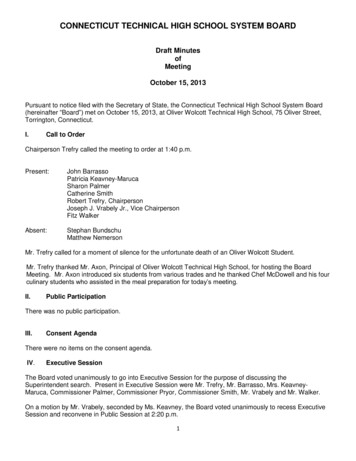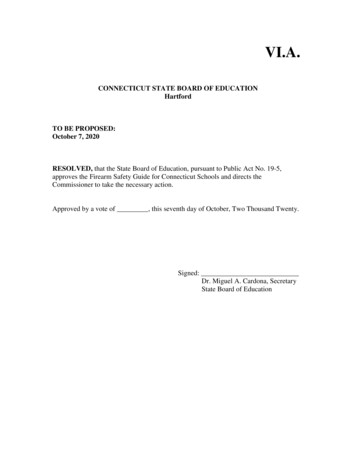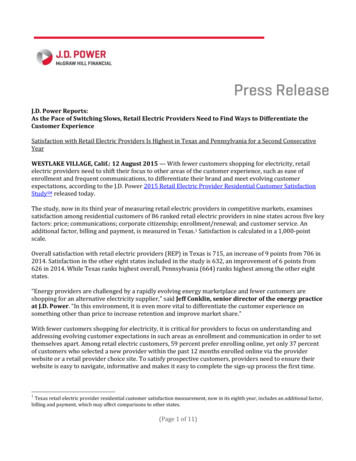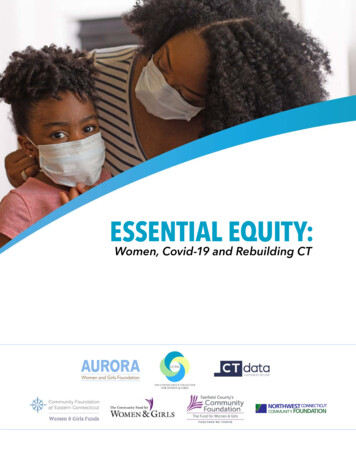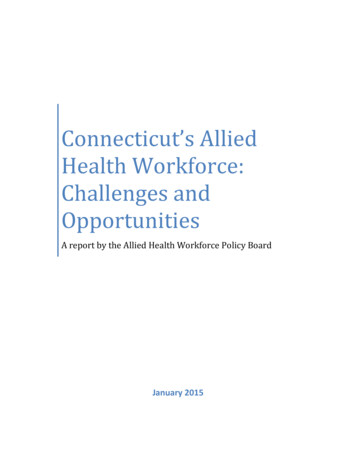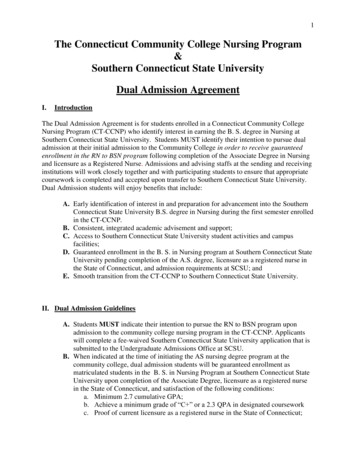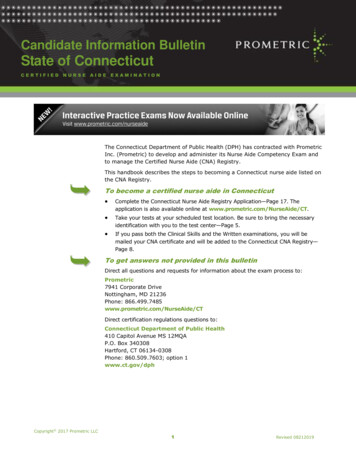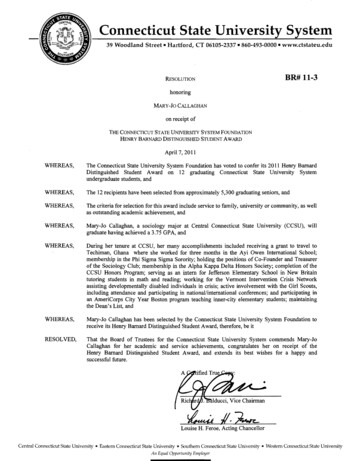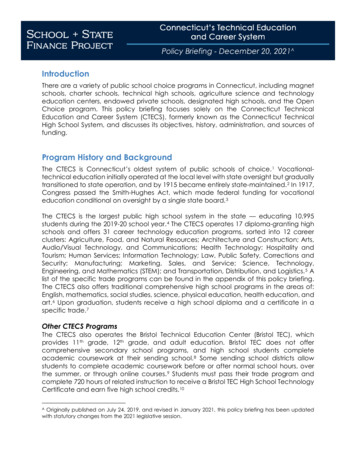
Transcription
Introduction AThere are a variety of public school choice programs in Connecticut, including magnetschools, charter schools, technical high schools, agriculture science and technologyeducation centers, endowed private schools, designated high schools, and the OpenChoice program. This policy briefing focuses solely on the Connecticut TechnicalEducation and Career System (CTECS), formerly known as the Connecticut TechnicalHigh School System, and discusses its objectives, history, administration, and sources offunding.Program History and BackgroundThe CTECS is Connecticut’s oldest system of public schools of choice. 1 Vocationaltechnical education initially operated at the local level with state oversight but graduallytransitioned to state operation, and by 1915 became entirely state-maintained. 2 In 1917,Congress passed the Smith-Hughes Act, which made federal funding for vocationaleducation conditional on oversight by a single state board. 3The CTECS is the largest public high school system in the state — educating 10,995students during the 2019-20 school year. 4 The CTECS operates 17 diploma-granting highschools and offers 31 career technology education programs, sorted into 12 careerclusters: Agriculture, Food, and Natural Resources; Architecture and Construction; Arts,Audio/Visual Technology, and Communications; Health Technology; Hospitality andTourism; Human Services; Information Technology; Law, Public Safety, Corrections andSecurity; Manufacturing; Marketing, Sales, and Service; Science, Technology,Engineering, and Mathematics (STEM); and Transportation, Distribution, and Logistics. 5 Alist of the specific trade programs can be found in the appendix of this policy briefing.The CTECS also offers traditional comprehensive high school programs in the areas of:English, mathematics, social studies, science, physical education, health education, andart. 6 Upon graduation, students receive a high school diploma and a certificate in aspecific trade. 7Other CTECS ProgramsThe CTECS also operates the Bristol Technical Education Center (Bristol TEC), whichprovides 11th grade, 12th grade, and adult education. Bristol TEC does not offercomprehensive secondary school programs, and high school students completeacademic coursework at their sending school. 8 Some sending school districts allowstudents to complete academic coursework before or after normal school hours, overthe summer, or through online courses. 9 Students must pass their trade program andcomplete 720 hours of related instruction to receive a Bristol TEC High School TechnologyCertificate and earn five high school credits. 10Originally published on July 24, 2019, and revised in January 2021, this policy briefing has been updatedwith statutory changes from the 2021 legislative session.A
2Bristol TEC also offers full-time, post-secondary school programs, as do the CTECS’s twoaviation maintenance technician schools: 11 1) CT Aero Tech School in Hartford and 2)Stratford School for Aviation Maintenance Technicians. In addition, six technical highschools offer part-time evening apprentice and extension courses. 12Student DemographicsFifty-seven percent of the 10,995 students attending CTECS schools during the 2019-20school year were identified as BIPOC, B while 43 percent were identified as white. 13Additionally, 11 percent of CTECS students required special education services; fourpercent were identified as English Learners; and 58 percent were classified aseconomically disadvantaged due to their eligibility for free or reduced-price lunch.Below are the totals and percentages of CTECS students by demographic compared tothe demographics of all of Connecticut’s 527,829 public school students.Figure 1: 2019-20 CTECS Demographics Compared toAll Connecticut Public School Students 14DemographicWhiteBIPOCSpecialEducationEnglish LearnerEconomicallyDisadvantagedTotal CTECSStudentsCTECSPercentage4,6776,31842%58%Total 49%The School and State Finance Project uses BIPOC (Black, Indigenous, People of Color) to refer to individualswho self-identify as American Indian or Alaska Native; Asian; Black or African American; Hispanic/Latino ofany race; Native Hawaiian or other Pacific Islander; or two or more races. Individual demographic categoriesand data used in the visualizations above comes from the Connecticut State Department of Education. Theacronym BIPOC is used in an effort to be as inclusive, succinct, and accurate as possible when using racialand ethnic demographics in our work. However, we know no single acronym, identifier, or label canaccurately define an individual or fully encompass the rich diversity of cultures, heritages, and backgroundsrepresented in the demographic data we use. For questions or comments about the demographic terms weuse, please contact us at info@schoolstatefinance.org.B
3Program Eligibility and Student ParticipationWhile many school choice programs are “blind admission,” wherein all students areeligible to attend the program if they choose to participate and an open seat isavailable, CTECS students must apply and meet criteria for admissions. While CTECS’schools are divided into four regions, any student who has completed eighth or ninthgrade and resides in Connecticut is eligible to apply for any CTECS school. 15 Studentsmay apply to start at the beginning of their ninth-grade year, or transfer mid-year duringtheir ninth- or 10th-grade years. 16Students can apply to up to four schools by submitting a form, completed by both thestudent and their parent/guardian, to the student’s school counselor, principal, orteacher. 17 The student’s school completes the sending school section and sends the fullapplication to the student’s first choice school. The application includes the previous andcurrent year transcript, previous and current year discipline record, previous and currentyear attendance report, a completed Student Interest Form, and the most recentSmarter Balanced Report. 18 The application items are assigned points and students areplaced on a ranked list by school based on their application’s total score. 19A CTECS school then sends a “First Step” letter to selected students in early February witha “Parent Response Form,” which is to be signed by the parent/guardian and returnedto the technical high school. 20 At the end of the school year, the accepted student’scurrent school sends the technical high school the following information for theaccepted student: 1) health and immunization records; 2) English Learner programrecords, if applicable; 3) final eighth-grade transcript indicating successful completion ofthe eighth-grade, or ninth-grade transcript if applying for 10th grade; and 4) final disciplinerecord that indicates no serious disciplinary infractions. 21If it is determined that a student applying to a CTECS school requires special educationservices, the student’s sending district is responsible for convening a “Planning andPlacement Team,” which includes a CTECS representative, to address the student’stransition to the CTECS school and ensure the student’s Individualized Education Programreflects the current supports and services necessary for the student to access a free,appropriate public education in the least restrictive environment. 22Beginning with the 2019-20 school year, students interested in attending technical highschools in the Hartford region (E.C. Goodwin Technical High School, A.I. Prince TechnicalHigh School, or Howell Cheney Technical High School) must apply through the RegionalSchool Choice Office (RSCO) of the Connecticut State Department of Education (CSDE),which handles applications for all public school choice programs in the Hartford area. 23The RSCO process for these schools differs from the other CTECS schools by not requiringreport cards or test scores, and by using a school assignment process that utilizes aselection algorithm that takes into account hometown and trade preferences. 24Students who enter a CTECS school at the beginning of ninth grade participate in acareer and technical exploratory program that “introduces each student to the goalsand objectives for career and technical programs; provides an objective measure ofstudent performance and a measure of potential for success for each student in all
4career and technical programs.” 25 The exploratory program is divided into three phases:1) Phase I provides information on all offered career and technical programs, withstudents transitioning between programs every two days; 2) Phase II provides hands-onexperience in three programs, with students transitioning between programs every fourdays; and 3) Phase III provides permanent placement in a career and technical programfor the next three years. 26,27Students who transfer to a CTECS school in the middle of ninth grade or enter in their 10thgrade year are exempted from the exploratory program requirement. 28 Curricula foreach grade at CTECS schools alternates every two weeks between technology classesfor trade certification and academic classes for state graduation requirements, eachover a total of 91 days, for a total of 182 days. 29,30Connecticut Technical Education and Career System GovernanceAdministrationThe Connecticut State Board of Education (SBOE) established and maintains the CTECS.However, the CTECS is advised by a separate state board of education called theConnecticut Technical Education System Board (referred to throughout this policybriefing as the CTECS board). 31 Currently, this board is made up of 11 members: fourexecutives of businesses based in Connecticut, nominated by the ConnecticutEmployment and Training Commission and appointed by the governor; five membersappointed by the SBOE; the commissioner of Connecticut’s Department of Economicand Community Development (DECD); and the commissioner of Connecticut’sDepartment of Labor (DOL). The chairperson, who serves on the SBOE as a nonvoting exofficio member, is appointed by the governor. 32A candidate for superintendent of the CTECS is recommended by the CTECS board tothe commissioner of the CSDE, who makes the decision to hire or reject the candidate. 33If the candidate is rejected, the CTECS board recommends another candidate to thecommissioner. The superintendent of the CTECS is “responsible for the operation andadministration of the technical education and career schools and all other mattersrelated to vocational, technical, technological and postsecondary education.” 34While each CTECS school is supervised by a principal and, depending on the size, two tothree assistant principals, 35 unlike traditional high schools, the principal is not involved inthe hiring of staff or the creation of positions. 36 The commissioner of the CSDE, inaccordance with policies established by the CTECS board, is responsible for staffingdecisions, establishing rules for the management of CTECS funding, and with expendingfunds appropriated from the General Fund for the CTECS schools. 37 However, becauseCTECS is a division of a state agency and its employees are state employees,Connecticut’s Office of Policy and Management is ultimately responsible for approvingnew positions or the filling of new positions. 38 In addition, when a vacancy does occur,collectively bargained rights may allow an employee a lateral transfer from anotherCTECS school. 39
5Additionally, each technical high school has a Career Technology Education AdvisoryCommittee (CTEAC) made up of local business and industry leaders and CTECSadministrators and teachers. 40 CTEACs advise on “program curricula; program facilities;state-of-the-art technology; occupational outlook; employability skills; and workplacecredentials.” 41Transition to an Independent AgencyIn 2017, the Connecticut General Assembly passed Public Act 17-237, which transitionsthe CTECS into an independent executive branch agency and out of the oversight ofthe CSDE. 42 Beginning July 1, 2022, the CTECS board will consist of 11 members, allappointed by the governor, with at least two members being alumni of the system orhaving experience in manufacturing or a trade offered by the CTECS, and two memberswho are executives of businesses based in Connecticut and who have been nominatedby the Governor’s Workforce Council. 43 The commissioners of the CSDE, the DECD, andDOL, or their designees, will serve as ex-officio members. 44Following this transition, an executive director, appointed by the governor, will beresponsible for the operation, administration, and financial accountability and oversightof the CTECS in matters relating to the central office, system-wide management, andother non-educational matters. 45 In addition, the superintendent of the CTECS will beappointed by the executive director at the recommendation of the CTECS board, andwill continue to be responsible for the operation and administration of the individualschools. 46This transition was initially intended to take effect July 1, 2019 47 but has been delayedtwice: 1) Conn. Act 17-2 §§ 72-82 (June Special Session) delayed the transition to July 1,2020; and 2) Conn. Act 19-117 §§ 273-284 further delayed the transition to July 1, 2022.Delaying the transition to an independent executive branch agency is anticipated tosave the State approximately 1 million, by delaying the hiring of 21 new administrativepositions. 48FundingOperating FundingThe CTECS is exclusively state-operated and funded out of the resources of the State ofConnecticut’s General Fund. 49 As a result, CTECS schools do not receive funding throughthe Education Cost Sharing (ECS) formula and CTECS students are not counted in theresident student count of the town in which they reside. The State provides, and assumesthe costs for, special education services required by CTECES students. 50 The CTECSexpended 155.9 million in expenditures in fiscal year 2019, 51 and the State appropriated 157.8 million to the system in FY 2020. 52 The graph below shows the budgeted stateexpenditures over the past five years. Please note these figures do not include the fringebenefit costs for past and current employees of the CTECS because those costs arebudgeted centrally for all state employees under the state comptroller.
6Figure 2: Total State Expenditures in Support of CTECS 53 200Expenditures (millions of ) 180 160 161 169 160 153 137 140 120FederalExpenditures 100 80 155 163FY 15FY 16 154 147FY 17FY 18 60 131StateExpenditures 40 20 0FY 19Fiscal YearThe State of Connecticut receives a federal grant specifically for technical education inthe form of “Career and Technical Education – Basic Grants to States” authorized underTitle I of the Carl D. Perkins Career and Technical Education Act of 2006. This grant was 10,844,369 for FY 2019, of which 202,196 went to the CTECS. 54,55 The State also receivesannual federal grants for CTECS under: Title I, Title II Part A, and Title III Part A of theElementary and Secondary Education Act (ESEA); the Individuals with DisabilitiesEducation Act (IDEA); Title IV Part A of the Every Student Succeeds Act (ESSA) (whenapplicable); the National Library Service for the Blind and Physically Handicapped (NLS)(when applicable); and 21st Century Community Learning Centers as part of ESSA (whenapplicable). 56 A breakout of these grants is included in the appendix of this policybriefing.Transportation FundingLocal and regional boards of education are responsible for the “reasonable andnecessary” transportation of students residing in their district to the CTECS school thestudent attends, regardless of where the CTECS school is located. 57 Under Conn. Gen.Statutes ch. 172, § 10-266m, local and regional boards of education are eligible for aformula-based grant to help offset the costs of transportation. 58 However, theConnecticut General Assembly has not appropriated funding for the transportation grantline item since 2016 and, as a result, districts do not receive any state funding fortransportation. 59 However, in order to comply with the Connecticut Supreme Court’s 1996ruling in Sheff v. O’Neill, and the case’s subsequent stipulated agreements, the Stateprovides funding to transport students to all school choice programs in the greaterHartford region — including CTECS schools in that region — that assist the State in meetingits obligations under Sheff. 60
7Capital FundingSimilar to operational expenses, capital improvement and capital equipment for theCTECS is funded entirely by the State. 61 The CTECS board is required to submit a 3-yearrolling capital plan to the General Assembly’s Education Committee; Finance, Revenueand Bonding Committee; and Appropriations Committee. 62 The most recent rollingcapital plan for the CTECS, covering FY 2019 through FY 2021, identified a need for 25.2million to cover educational equipment, technology, infrastructure, vehicles, and energyefficiency projects. 63The General Assembly authorizes general obligation bonds to the CSDE, which issuesgrants to the CTECS for existing building and grounds improvements, equipment tools,vehicles, and technology upgrades. 64 From FY 2014 through FY 2020, the GeneralAssembly authorized 37.5 million in bonding for the CTECS. C Of that authorized bondingamount, 6.77 million is unallocated as of July 1, 2020. 65Connecticut’s Department of Administrative Services includes CTECS school constructionprojects on its list of school building projects, and approves applications for grants to assistthe CTECS with repairing fire damage; correcting health, safety, and other codeviolations; replacing roofs; remedying air quality emergencies; and/or purchasing andinstalling portable classroom buildings. 66Employee Classification and BenefitsCTECS schools are state property and are operated with state funding. As a result, allCTECS employees are state employees and are provided full state health and pensionbenefits. CTECS teachers are allowed to choose between the State Employee RetirementSystem (SERS), where members contribute to a defined-benefit pension and pay SocialSecurity, or the Teachers’ Retirement System (TRS), where members contribute to adefined-benefit pension but do not pay into Social Security. 67 A report by the GeneralAssembly’s Office of Legislative Research explains a scenario where a teacher wouldchoose the TRS system:In one common scenario, the technical high school system hires a teacher whohas already worked for a local board of education and therefore is in the TRS.Since the teacher wants to continue building a TRS pension, he or she opts to stayin the TRS even though the teacher could join SERS and therefore also pay intoSocial Security. 68Administrative staff who hold a SBOE certificate or permit, such as guidance counselors,are considered teachers under the law and have the option to join SERS or TRS. 69 Noncertified staff are required to be members of SERS. 70C Since FY 2014, the General Assembly has authorized 55.5 million in general obligation bonds for the CTECS.However, this amount was reduced by 12 million under Conn. Act. 16-4 § 215 and 11 million under Conn.Act 17-2 § 504 (June Special Session), resulting in a total of 32.5 million in available general obligation bondauthorizations.
8AppendixThe table below details the number of students enrolled in each CTECS school, listed byregion and school.Table 1: CTECS Enrollment by Region and School, 2019-20 71SchoolA.I. Prince Technical High SchoolBullard-Havens Technical High SchoolE. C. Goodwin Technical High SchoolEli Whitney Technical High SchoolElla T. Grasso Technical High SchoolEmmett O’Brien Technical High SchoolH. C. Wilcox Technical High SchoolH. H. Ellis Technical High SchoolHenry Abbott Technical High SchoolHowell Cheney Technical High SchoolJ. M. Wright Technical High SchoolNorwich Technical High SchoolOliver Wolcott Technical High SchoolPlatt Technical High SchoolVinal Technical High SchoolW. F. Kaynor Technical High SchoolWindham Technical High SchoolTown/CityHartfordBridgeportNew 79702696643428663611805420800464Waitlist 72,D*493*219513518442204*371411854611380109* Denotes data not provided by the CSDEDWaitlist counts are based on applications. Students may apply to more than one school.
9Table 2: CTECS Resident Town Count for the 2019-20 School Year(as of October 1, 2019) 73, ETownAndoverAnsoniaAshfordAvonBarkhamstedBeacon ryCromwellResident TownCount 30*4722TownDanburyDarienDeep RiverDerbyDurhamEastfordEast GranbyEast HaddamEast HamptonEast HartfordEast HavenEast LymeEastonEast sident TownCount 14518641829Data is suppressed pursuant to data suppression guidelines from the CSDE. Any cell with a value less thanor equal to five is suppressed.F The totals for the following towns include students attending Bristol TEC, which does not offer comprehensivesecondary school programs and high school students complete academic coursework at their sendingschool: Berlin, Bristol, Burlington, Cheshire, Farmington, Goshen, Harwinton, Litchfield, Plainville, Plymouth,Portland, Southbury, Southington, Torrington, Union, Wallingford, Watertown, West Hartford, Winchester, andWoodbury.E
ordMonroeMontvilleMorrisNaugatuckNew BritainNew FairfieldNew HartfordNew HavenNewingtonNew LondonNew MilfordNewtownNorfolkNorth BranfordNorth CanaanNorth HavenNorthStoningtonNorwalkNorwichOld LymeOld SaybrookOrangeResident TownCount amReddingRidgefieldRocky manSimsburySomersSouthburySouthingtonSouth nt TownCount 5435160*42722631622*7229130*
okWest HartfordWest HavenWethersfieldWillingtonResident TownCount sor nt TownCount F46270211441*182311,080
12Table 3: CTECS Career and Technical Programs for the 2019-20 School Year 74Career ClusterAgriculture, Food and Natural ResourcesArchitecture and ConstructionArts, Audio Visual Technology andCommunicationsHealth TechnologyHospitality and TourismCareer PathwayBioscience and es ManagementHeating, Ventilation and Air Conditioning(HVAC)MasonryPlumbing and HeatingPlumbing, Heating and CoolingSustainable ArchitectureDigital MediaSound Production TechnologyBiotechnologyHealth TechnologyCulinary ArtsCulinary Arts and Guest ServicesTourism, Hospitality and Guest ServicesManagementHuman ServicesHairdressing and CosmetologyInformation TechnologyElectronics TechnologyGraphics TechnologyInformation Systems TechnologyLaw, Public Safety, Corrections andSecurityManufacturingMarketing, Sales and ServiceScience, Technology, Engineering andMathematics (STEM)Transportation, Distribution and LogisticsCriminal Justice and Protective ServicesAutomated Manufacturing TechnologyMechanical Design and EngineeringTechnologyMechatronicsPrecision Machining TechnologyWelding and Metal FabricationMarketing, Management andEntrepreneurshipPre-Electrical Engineering and AppliedElectronics TechnologyAutomotive Collision Repair andRefinishingAutomotive TechnologyDiesel and Heavy-Duty Equipment Repair
13Table 4: Federal Grants Received by the CTECS, FYs 2015-19 75YearTitle ITitle IIPart ATitle IIIPart ATitle IVPart AIDEANLSCCLCTOTAL2019 3,266,5032018 2,928,0752017 2,939,6772016 2,802,8242015 2,557,0902014 2,595,349 501,278 516,544 528,393 558,186 566,328 567,830 54,847 48,846 52,879 57,211 53,795 44,924 198,715 198,838---- 2,443,919 6,155,197 2,447,573 20,000 6,064,430 2,350,498 19,998 5,722,290 2,335,730 81,879 5,795,917 2,544,873 2,530,393 6,566,216 6,423,073
14EndnotesMoran, J.D. (2018). Issue Brief: Public Schools of Choice (2018-R-0286). Hartford, CT: Connecticut GeneralAssembly, Office of Legislative Research. Retrieved from .2 Sullivan, M. (2017). Research Report: Connecticut Technical High School System (2017-R-0070). Hartford,CT: Connecticut General Assembly, Office of Legislative Research. Retrieved from f.3 Ibid.4 Enrollment data provided to the School and State Finance Project by the Connecticut State Departmentof Education.5 Connecticut Technical Education and Career System. (2019). Working for Students and Connecticut’sFuture: Strategic Operating Plan: 2019-2022. Hartford, CT: Author. Retrieved from https://cttech.org/wpcontent/uploads/2020/04/ctecs strategicoperatingplan lores spreads-final1.pdf.6 Connecticut Technical Education and Career System. (2018). Biennial Summary Report, 2016-17 and 201718. Hartford, CT: Author. Retrieved from /CTECS-BiennialReport.pdf.7 Ibid.8 Bristol Technical Education Center. (n.d.). Admissions. Retrieved from http://bristol.cttech.org/admissions.html.9 Ibid.10 Ibid.11 Connecticut Technical Education and Career System. (2018). Biennial Summary Report, 2016-17 and2017-18. Hartford, CT: Author. Retrieved from /CTECSBiennial-Report.pdf.12 Ibid.13 Demographic data provide to the School and State Finance Project by the Connecticut StateDepartment of Education.14 Ibid.15 Connecticut State Department of Education. (n.d.). Connecticut Technical Education and CareerSystem: FAQs. Retrieved from ystem/FAQ.16 Sullivan, M. (2017). Research Report: Connecticut Technical High School System (2017-R-0070). Hartford,CT: Connecticut General Assembly, Office of Legislative Research. Retrieved from f.17 Connecticut Technical Education and Career System. (2019). Application for Student Admission, 20192020. Hartford, CT: Author. Retrieved from ons/20192020/2019 20%20application%20with%20rsco%20edits.pdf.18 Ibid.19 Connecticut Technical High School System. (2018). CTHSS Application Process for Students Entering in the2018-2019 School Year. Hartford, CT: Author. Retrieved from 018-2019.pdf.20 Connecticut Technical Education and Career System. (2019). Application for Student Admission, 20192020. Hartford, CT: Author. Retrieved from ons/20192020/2019 20%20application%20with%20rsco%20edits.pdf.21 Ibid.22 Conn. Acts 21-144.23 Connecticut Technical Education and Career System. (n.d.). Admissions. Retrieved fromhttp://www.cttech.org/admissions.html.24 Peterson, G. (2019, July 8). Personal communication with the Education Division Director of the Office ofStudent Supports and Organizational Effectiveness, Connecticut State Department of Education.25 Connecticut Technical High School System. (2017). Program of Studies, 2018-2019. Middletown, CT:Author. Retrieved from 20studies/pos-3-28-18-20182019.pdf.26 Ibid.1
15Connecticut Technical High School System. (2015). Comparison of Traditional High School versusConnecticut Technical High School System (CTHSS). Middletown, CT: Author. Retrieved issions/CTHSS%20Considerations(1).pdf.28 Connecticut Technical High School System. (2017). Program of Studies, 2018-2019. Middletown, CT:Author. Retrieved from 20studies/pos-3-28-18-20182019.pdf.29 Connecticut Technical High School System. (2015). Comparison of Traditional High School versusConnecticut Technical High School System (CTHSS). Middletown, CT: Author. Retrieved issions/CTHSS%20Considerations(1).pdf.30 Committee on Technical and Career Institutions. (2017). Connecticut CTE Profile. Burlington, MA: Author.Retrieved from Downloads pdf/cteprofile Connecticut.pdf.31 Conn. Gen. Statutes ch. 164, § 10-95(a).32 Ibid.33 Conn. Gen. Statutes ch. 164, § 10-95q34 Conn. Gen. Statutes ch. 164, § 10-95q(b).35 Connecticut Technical Education and Career System. (2018). Biennial Summary Report, 2016-17 and2017-18. Hartford, CT: Author. Retrieved from /CTECSBiennial-Report.pdf.36 Committee on Technical and Career Institutions. (2017). Connecticut CTE Profile. Burlington, MA: Author.Retrieved from Downloads pdf/cte-profile Connecticut.pdf.37 Conn. Gen. Statutes ch. 164, § 19-95(b).38 Committee on Technical and Career Institutions. (2017). Connecticut CTE Profile. Burlington, MA: Author.Retrieved from Downloads pdf/cte-profile Connecticut.pdf.39 Ibid.40 Connecticut Technical
The Connecticut State Board of Education (SBOE) established and maintains the CTECS. However, the CTECSis advised by a separate state board of education called the Connecticut Technical Education System Board (referred to throughout this policy briefing as the CTECS board). 31. Currently, this board is made up of members: four 11
